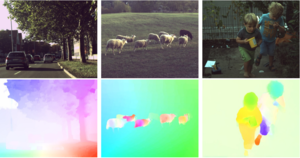Slow Flow: Exploiting High-Speed Cameras for Accurate and Diverse Optical Flow Reference Data
2017-06-01
Existing optical flow datasets are limited in size and variability due to the difficulty of capturing dense ground truth. In this paper, we tackle this problem by tracking pixels through densely sampled space-time volumes recorded with a high-speed video camera. Our model exploits the linearity of small motions and reasons about occlusions from multiple frames. Using our technique, we are able to establish accurate reference flow fields outside the laboratory in natural environments. Besides, we show how our predictions can be used to augment the input images with realistic motion blur. We demonstrate the quality of the produced flow fields on synthetic and real-world datasets. Finally, we collect a novel challenging optical flow dataset by applying our technique on data from a high-speed camera and analyze the performance of the state-of-the-art in optical flow under various levels of motion blur. Includes high-frame-rate version of the Sintel dataset.
| Author(s): | Joel Janai and Fatma Güney and Jonas Wulff and Michael Black and Andreas Geiger |
| Department(s): |
Autonomous Vision Perceiving Systems |
| Publication(s): |
Slow Flow: Exploiting High-Speed Cameras for Accurate and Diverse Optical Flow Reference Data
|
| Authors: | Joel Janai and Fatma Güney and Jonas Wulff and Michael Black and Andreas Geiger |
| Release Date: | 2017-06-01 |
| Repository: | https://github.com/autonomousvision/slow_flow |
| External Link: | http://www.cvlibs.net/projects/slow_flow/ |






